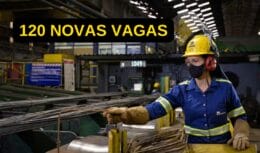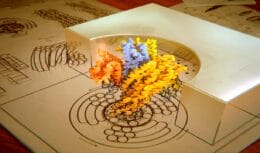
The news about Venezuela's moves to explore and sell the mineral to Russia, creates a warning in the government is false
In August 2020, a report from the military area warned Planalto about Venezuela's moves to explore and sell niobium to Russia. The illegal extraction of niobium by the Venezuelan government and Russia's entry into the game worried the military. However, there is no evidence that this fact is true.
Read also
The military area reminds Planalto that the United States defined the niobium as a strategic material for the development of Brazil. The metal is mainly used in the production of special steels and superalloys and works as an “improver”: 400 grams per ton are enough to produce lighter and more resistant steels.
According to data from the Geological Survey of Brazil – CPRM, a public company linked to the Ministry of Mines and Energy, Brazil is responsible for around 98% of the world's niobium reserves and 90% of all transactions related to the ore. However, there are no indications that there is smuggling of the mineral to the countries mentioned by the published report. Experts claim that the commercialization of niobium is financially unattractive in this illegal activity.
Scourge of illegal mining
The state of Amazonas, where the niobium deposits, is also the state with the most threatened indigenous reserves – a total of 30 seen by land grabbers, landowners and oil and gas companies.
Mining companies have been pushing for a change in Brazilian legislation that would allow them not only to mine in a reserve, but also in protected indigenous lands across the country.
Such a change could be introduced through the mining law long stalled in Congress, however it faces a number of obstacles. One of them comes from the Brazilian Constitution.
The Brazilian Constitution establishes that no measure can be authorized to allow mining in indigenous areas before a series of prerequisites are satisfied, including the consent of the affected communities.
The Mines and Energy Commission, for example, has already rejected a proposal that created a national policy for niobium production and demanded that only 100% Brazilian companies could exploit niobium. Another 3 projects on niobium processing were rejected by the same Company (PLs 1581/15, 11088/18 and 11249/18).
O niobium – also known as columbium – is relatively uncommon in the world, but abundant in Brazil. It is an important element used as an additive to steel products in industrial applications including automobiles, aircraft, pipelines, spacecraft, nuclear weapons and even drilling.
more and more this mineral has become essential for technology and required in the market for its characteristics of resistance to high temperatures and corrosion. Furthermore, niobium is the metallic element with the lowest concentration in the Earth's crust, being found in nature at a proportion of 24 parts per million.
Niobium (Nb) is a transition metal., and got this name because it was inspired by the Greek goddess Niobe, who also baptized the character (cat) of the Roma series. It occurs primarily as an oxide and has a strong geochemical coherence with tantalum.
The main niobium minerals are pyrochlore [(Na, Ca) 2Nb2O6F] and columbite [(Fe, Mn) (Nb, Ta) 2O6], composed of niobate, tantalate, iron and manganese. Columbite is found in intrusive pegmatite and biotite and in alkaline granites. However, since most of these deposits are small and poorly distributed, they are usually mined as a by-product of other metals.
Brief history of niobium exploration in Brazil
The world's first large niobium reserve was discovered in 1960 in Araxá. Five years later, the American Arthur W. Radford, a member of the board of the mining company Molycorp, and the Brazilian banker Walther Moreira Salles set up a company to explore this element.
The association between the investments of the Brazilian banker and the mining company in which the American was a director – and which had acquired some mines in Araxá – resulted in the emergence of the Companhia Brasileira de Metalurgia e Mineração (CBMM).
In 1965, the Brazilian government allowed the Companhia Brasileira de Metalurgia e Mineração (CBMM), in partnership with the US government, to explore the reserves available in the country. At that time, niobium had no proven use.
Only in 1970 after some study it was attributed to commercial utilities niobium. It was at that time that Salles, also the owner of Banco Itaú, began to gradually buy the part of the company that belonged to the Americans.
CBMM markets niobium in the form of metallic alloys, such as ferroniobium, which is made up of 2/3 niobium and 1/3 iron. In 2011, Companhia Brasileira de Metalurgia e Mineração traded 30% of its shares with an Asian company with some caveats, among them, that confidentiality be maintained regarding the niobium processing steps developed by Salles' company
Anglo American Brazil, on the other hand, explores niobium in Catalão, in the state of Goiás. Analogous to this, we can mention the reserves of this ore that exist in the Amazon. There are two known niobium deposits in the region, at Seis Lagos and at Santa Isabel do Rio Negro.
What is the probability of developing niobium in the Amazon?
Comprising a biological reserve covering 36.900 hectares (91.181 acres) of primary rainforest, Six Lakes also includes an inselberg hill – an isolated rocky outcrop – and six lakes, each with water of different colors due to different dissolved minerals, such as iron, manganese and niobium.
Seis Lagos is located in São Gabriel da Cachoeira (AM), mineral rights of the Geological Survey of Brazil/CPRM, has about 2,9Gton at 2,81% Nb2O5, which would give around 81,4 Mton of contained niobium oxide, that is, about 14 times the current known reserves in the world.
Between Seis Lagos and Santa Isabel do Rio Negro lies Pico da Neblina, the highest peak in Brazil at 2.995 meters (9.827 feet) above sea level. Niobium deposits are located in the Rio Negro basin, the largest blackwater basin in the world. Twenty-three indigenous groups, including the Yanomami people, live in the Brazilian portion of the Rio Negro basin.
The country has enough reserves to sustain the world's demand for niobium for the next 200 years. Doing a total survey, 98,2% of the planet's niobium reserves are in Brazil.
There is great bet and speculation about the commercialization of niobium and the benefits it could bring to Brazil, however, despite the possibilities of using the ore, it can be replaced by vanadium or titanium, for example, which are more accessible to other countries. The cost of exploiting niobium is still very high.
Finally, the amount of niobium required for the production of metallic alloys for industrial use is very small, causing a devaluation based on supply and demand. For niobium to be traded at higher prices, the ideal would be to add value to the ore using it in new technologies and avoid selling the compound as a raw material.
Brazil is world leader in niobium production
Almost all niobium in the world is in Brazil. The country is recognized as a leading producer and participant in the global market for commodities minerals, in particular metallic minerals. Among these, iron ore, copper, gold, aluminum and niobium stand out.
According to the National Mining Agency (ANM), the country holds around 98% of the niobium deposits in operation in the world, which represents a domain of 82% of the global market.
The largest Brazilian reserves are concentrated in the city of Araxá (MG) with 75% of niobium deposits, followed by Amazonas with 21% of non-commercial deposits and another 4% are in Catalão (GO).
A Brazilian Metallurgy and Mining Company (CBMM) is responsible for exploring niobium in Brazil under the concession regime. Brazilian niobium is extremely coveted by the foreign market, without national exploitation, destined outside the country.
In 2018, CBMM sent 95 tons of niobium iron, metallic niobium, niobium nickel and niobium oxide to the foreign market, according to a survey by Revista Pesquisa Fapesp.
Approximately 10% of all steel produced in the world contains Niobium as an alloying element. China is the main market that demands this element, consuming about 25% of all world production, mainly for steel production (it produces about half of the world's steel).
Companhia Brasileira de Metalurgia e Mineração do Brasil increases ferroniobium capacity to meet growing demand from the technology sector
Companhia Brasileira de Metalurgia e Mineração recently completed a $555 million expansion at its ferroniobium plant in Araxá, Minas Gerais state in southeastern Brazil. This fact will provide an increase in sales of ferroalloys that mainly supply the global automotive sector, renewable energy and electronics.
Ferroniobium capacity at the CBMM plant was estimated to be around 100.000 tonnes/year prior to expansion. With this expansion, the plant's ferroniobium production capacity has increased to 150.000 tons/year, ie this is more than the current total market demand of around 110.000 tons/year.
The ferroniobium market has shrunk to around 95.000 tonnes in 2020 due to the impact of the COVID-19 pandemic. Last year, CBMM sold around 72.000 tons of ferroniobium.
The use of ferroniobium is growing in high-strength low-alloy steel applications in the automotive industry, in superalloys for turbines including wind turbines, in semiconductors and medical imaging equipment, and it is also used in pipelines, he said. Niobium oxide is the raw material for the production of superalloys.
Brazil has the largest niobium reserves in the world and CBMM is the largest niobium producer in the world, producing niobium and ferroniobium oxide, which he describes as his main business and flagship product.
Brazil produces the Fe-Nb alloy and other products, in addition to actively participating in all segments involving Niobium. CBMM – Cia Brasileira de Metalurgia e Mineração (privately owned) holds around 80% of the national production, the rest with Mineração Catalão de Goiás; CBMM mines in the open and without the use of explosives
Ferroniobium is also produced by China Molybdenum Corp in Brazil and Niobec in Canada. Other countries with potential deposits of niobium are: Angola, Russia, Saudi Arabia, Democratic Republic of Congo, Denmark, Finland, Gabon, Tanzania, Nigeria, Malawi, Ethiopia, USA, among others.
1st Brazilian Niobium Fair and inauguration of new CNPEM/MCTI facilities in Campinas (SP)
The President of the Republic, Jair Bolsonaro, and Ministers Marcos Pontes, from the Ministry of Science, Technology and Innovation (MCTI), and Milton Ribeiro, from the Ministry of Education (MEC), will participate on the afternoon of October 8, 2021, in a series of events and inaugurations at the National Center for Research in Energy and Materials (CNPEM), a social organization supervised by the MCTI.
Niobium, considered one of the “new metals”, had its use highlighted by cutting-edge technologies that emerged in recent years. In Brazil, the most exploited are, in particular, the Rare Earth Metals (REE), niobium, tantalum, lithium, vanadium, copper and nickel.
The 1st Brazilian Niobium Fair presented products already developed by the companies together with the academy, aimed at the application of the mineral in order to contribute to the positioning of Brazil on the world stage as a reference focused on the production, characterization and application of niobium.










